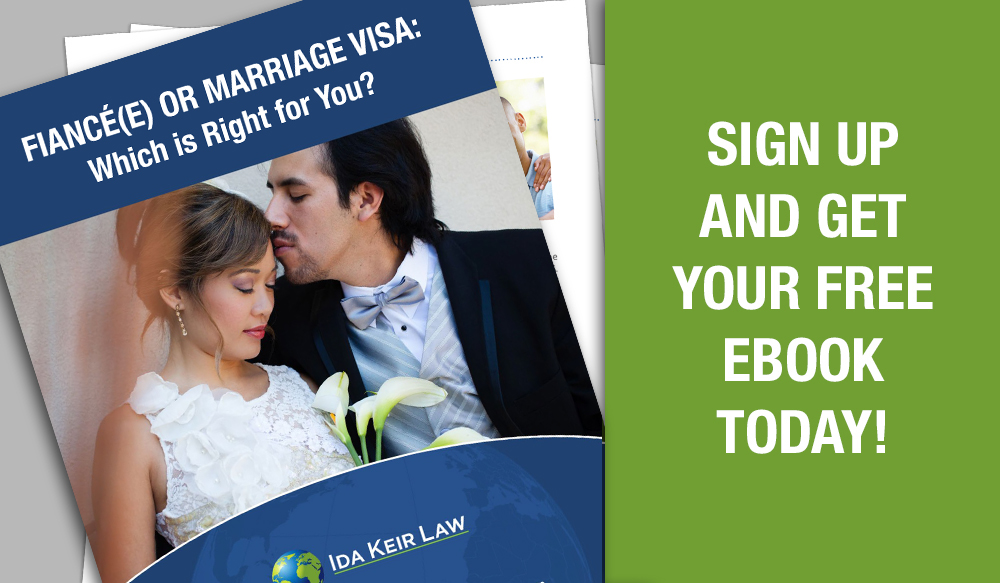Should you apply for a 90 day fiancé visa or marry overseas, and then apply for a spousal visa? This page has information on the fiancé visa process. Go to the green card page to find out more about marrying first, then applying for a green card. Or read this post for a comparison of the two visas!
There’s a special visa, the K-1, for a U.S. Citizen to apply for an overseas fiancé. Green card holders cannot apply for their fiancé. If granted, the K-1 visa allows the foreign fiancé to come to the U.S. to marry within 3 months, and then apply to “Adjust Status” or get a Green Card while remaining in the U.S. Same-sex couples are treated the same as other couples; you must prove all the following, and then get married in the U.S. where same-sex marriage is legal in all states.
The government looks for fraud and you have to prove:
- You’re a U.S. Citizen.
- You plan to marry within 90 days of your fiancé entering the United States.
- You and your fiancé are both free to marry. Any prior marriages must have been legally terminated by divorce, death, or annulment – you’ll need to provide all legal documents to show this.
- You met each other, in person, at least once within 2 years of filing your petition unless this would violate strict and long-established customs of your or your fiancé’s foreign culture or social practice, or such a meeting would result in extreme hardship to you. You must get a waiver of the meeting requirement if one of these applies to you.
The U.S. citizen also cannot have a prior specified criminal offense conviction against a minor under the Adam Walsh Act. These include sex offenses and kidnapping. If he does have such a conviction, there are some exceptions but they are difficult to get.
To apply for a fiancé visa, you must file an I-129F petition with U.S. Citizenship & Immigration Services (USCIS) and enclose documents to prove all requirements above. As of July 2022 that first step normally takes 5-13 months from the time you file, or longer if the government asks for more evidence. If approved, the papers next go to the National Visa Center (NVC) and then to the embassy which processes the case for interview. During the Covid-19 pandemic this part of the process is proceeding much more slowly than before. The foreign fiancé then completes the online Form DS-160 application and requests an interview where numerous documents are required including confirmation of the online application and fee payment; passport; death or divorce certificates for both the fiancé and the U.S. citizen petitioner; police certificates; medical examination; an I-134 Affidavit of Support with supporting evidence; photographs of yourself; and proof of the relationship. Proof of a genuine relationship is especially important.
As we explained above, there’s no guarantee the embassy will approve your fiancé visa application! It’s completely up to the embassy and you’ll get very little time. How can an immigration lawyer help? We know the requirements and the many documents and evidence you’ll need for the petition and your interview. Our knowledge should help you get through the process faster and with fewer problems. Sometimes couples waste months and months getting ready because they don’t know what’s needed.
Your interview is very important, as the officer will decide if s/he believes your relationship is genuine. We’ll help you prepare for your interview – not tell you what to say – so you won’t be as nervous at your interview. It’s much better to have your papers and case in order before you begin so don’t need to worry about that. It’s very difficult to change the mind of the consular officer if they decide against you and there are few rights of appeal. Typical time spent on the K-1 process is about 6-12 months (or longer during the pandemic) and it helps to get good legal advice to make sure you have the strongest possible case for your interview.
If the K-1 visa is granted, the fiancé can enter the U.S. and you must marry within 90 days. The fiancé can apply for a work permit valid for 90 days upon entry but most don’t. If the marriage doesn’t take place, that’s the end of the visa and the work permit and the fiancé must leave the country. If the marriage does take place, the foreign spouse can file an I-485 petition to adjust status and get their green card. The K-1 visa is good for one entrance into the U.S. You can’t leave the US and re-enter on this visa.
Filipino K-1 Visas – What are the main reasons a K-1 visa is denied?
There are more K-1 applications in Manila than anywhere else in the world so the Manila embassy is very familiar with them. The embassy’s website used to state:
“K-1 applications are subject to the same review standards as immigrant visa applications. The main reasons for visa refusal are: lacking documentation; need to review or verify evidence of the relationship; lack of a petitionable relationship; misrepresentation of the facts; medical concerns; criminal grounds and potential public charge.
A common basis for refusal is a prior marriage for the beneficiary or the petitioner that has not been legally terminated. There is no divorce in the Philippines. A consular officer will only accept a death certificate or a court ruling of annulment or of presumptive death as evidence that a Filipino marriage has been terminated. A U.S. citizen may terminate a Filipino marriage through a U.S. divorce.” Click here for more information on fiancé visas from the U.S. State Department’s website.
Contact us today for help with your fiancée visa application!

